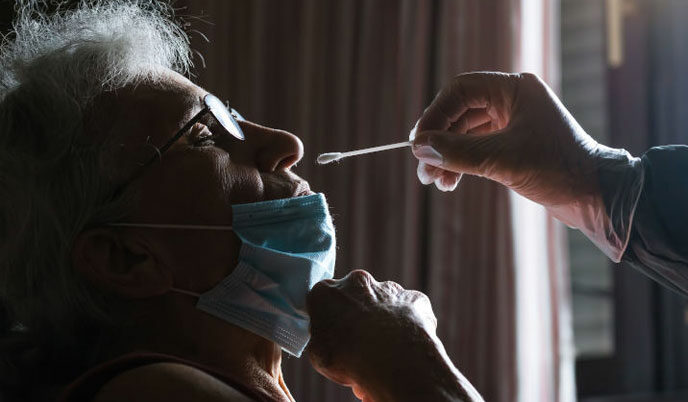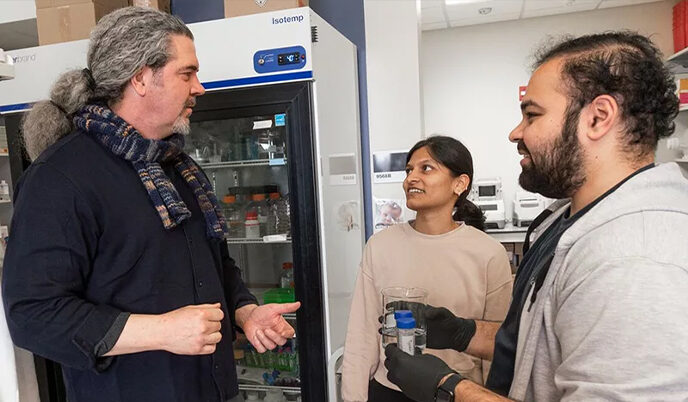
Study explores midlife factors associated with blood biomarkers of neurodegeneration and Alzheimer’s disease
Lifestyle and chronic health conditions in middle age, along with a person’s education level, show associations with emerging blood markers of neurodegeneration and Alzheimer’s disease, according to a new study by researchers at the University of Wisconsin School of Medicine and Public Health.

Study finds teens, young adults benefit from clinician advice about safe social media use
Teens and young adults who received a brief social media counseling session during a health care visit remembered the lessons and reported safer online behavior six months later, according to a large new study from the University of Wisconsin School of Medicine and Public Health.

Richard Keller named chair of Medical History and Bioethics
Richard Keller, a distinguished scholar of the social and historical dynamics of climate change and natural disasters, has become the next chair of the Department of Medical History and Bioethics at the University of Wisconsin School of Medicine and Public Health.

Tamara Scerpella to become chair of Orthopedics and Rehabilitation
Dr. Tamara Scerpella, a nationally renowned orthopedic surgeon, academic leader, mentor and researcher, will become the next chair of the Department of Orthopedics and Rehabilitation at the University of Wisconsin School of Medicine and Public Health.

Nursing home residents benefit from rapid flu testing
Rapid on-site testing of nursing home residents for influenza allowed earlier detection of outbreaks, faster treatment with antiviral medication and much lower hospitalization rates, according to a new study from researchers at the University of Wisconsin School of Medicine and Public Health.

Clinical trial for severe dry mouth treatment launching soon at UW
The UW Health | Carbone Cancer Center and UW Program for Advanced Cell Therapy, or PACT, will soon begin a clinical trial using a recently developed cell therapy to treat severe dry mouth, which is a significant symptom of graft-versus-host disease and Sjögren’s disease.

UW Carbone Cancer Center receives SPORE designation, federal grant to support prostate cancer research
University of Wisconsin Carbone Cancer Center will be designated as a Specialized Program of Research Excellence, or SPORE, by the National Cancer Institute (NCI) for research initiatives to advance new prostate cancer treatments.

UW Health, UW School of Medicine and Public Health launch UW Clinical Trials Institute
UW Health and the UW School of Medicine and Public Health are announcing the formation of the University of Wisconsin Clinical Trials Institute to advance health care innovations via clinical trials at UW–Madison.

Survey highlights changes in Wisconsinites’ alcohol consumption during COVID-19 pandemic
A new survey from the University of Wisconsin School of Medicine and Public Health details which populations experienced the greatest change in alcohol use during the COVID-19 pandemic, finding that higher-earning younger adults increased drinking the most.

Ed Chapman’s tenacious approach to the “most important” problems in biology
No matter how obscure his latest study of fundamental nervous processes might seem, Ed Chapman will try to ease people’s minds.

Elizabeth Quinlan chosen as new chair of Department of Neuroscience
Elizabeth Quinlan, an accomplished research scientist and strategic leader, will be the next chair of the Department of Neuroscience at the University of Wisconsin School of Medicine and Public Health.

UW study details how HPV may promote head and neck cancer
Cancer researchers have long known that the sexually transmitted human papillomavirus (HPV) is a leading cause of head and neck cancer and now a study from the University of Wisconsin School of Medicine and Public Health sheds light on how HPV turns healthy cells into cancer.